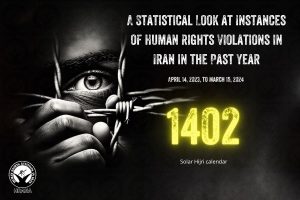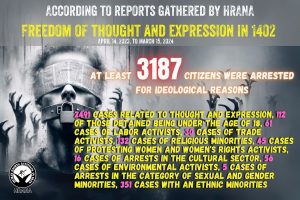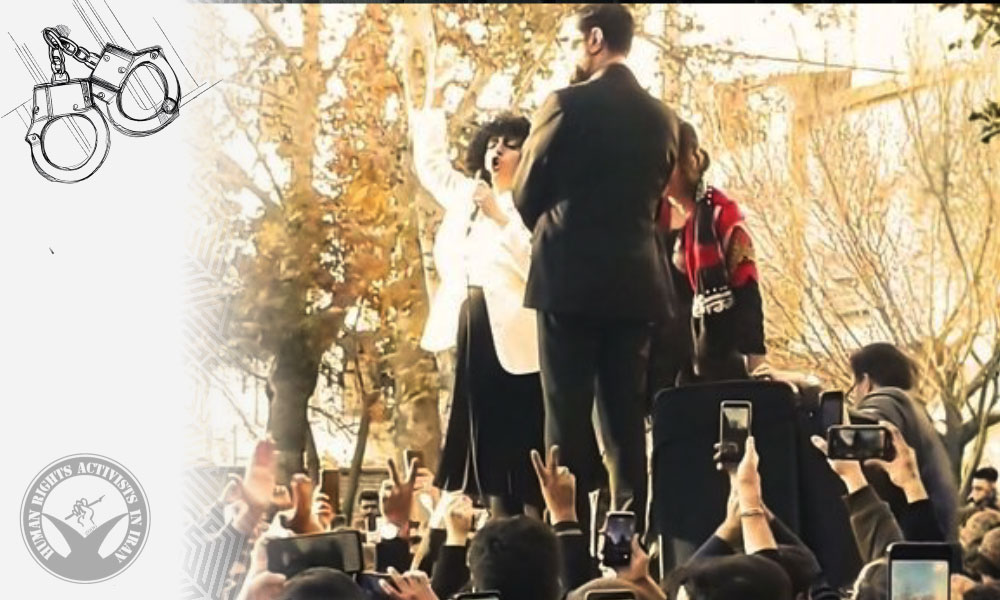HRANA – The year 1402 (April 14, 2023 – March 15, 2024) paints a vivid picture of the ongoing human rights violations in Iran. The persistent threats to freedom of thought and expression, the crackdown on peaceful protestors, increased pressures on ethnic and religious minorities, trials and harassment of human rights activists, executions of juveniles, the plight of child laborers, violations of the rights of women and sexual and gender minorities, and the unsatisfactory conditions of detention centers and prisons are just some examples of the daily infringements on human rights in Iran. The comprehensive report from the HRA Center for Statistics and Data (HRACSD) that follows presents a regrettable state of human rights violations in Iran over the past year.
According to data from 10,133 reports registered at the HRACSD during the past year (March 21, 2023, to March 15, 2024), 3,187 citizens were arrested in Iran based on ideological or political grounds or in direct conflict with human rights principles. In addition, 672 arrests were related to individuals’ lifestyles.
Key areas of arrest included 2,491 cases in the realm of the right to freedom of thought and expression, with 112 of those detained being under the age of 18. There were also 61 cases of worker and labor activist arrests, 30 cases involving professional activists, 132 arrests of religious minorities, 45 arrests of women protestors and women’s rights activists, 16 in the cultural sector, 5 arrests of sexual and gender minorities, 56 environmental activists, and 351 individuals arrested on an ethnic basis. It should be noted that the charges against 330 individuals in the latter category are unspecified, but based on patterns and the security institution’s history in the mentioned areas, these arrests are classified under ethnic-national rights.
Aside from the 3,187 arrests with a political or ideological basis, at least another 672 citizens were detained for choosing their lifestyle and attending private parties across various cities in Iran. These detentions highlight the intrusion into citizens’ private lives and inspection of their lifestyle choices, contrary to the law and accepted human rights principles.
Moreover, general and revolutionary courts across the country issued sentences in 843 cases, amounting to a total of 31,809 months of custodial sentences and 1,981 months of suspended sentences for ideological or security-related offences. Of these, 25,197 months of imprisonment were issued by first-instance courts, 8,113 months by appellate courts, and 480 months by the Supreme Court. In addition to imprisonment, monetary fines were also levied against the convicts, totalling approximately seven billion, six hundred twenty-three million, two hundred fifty-nine thousand Tomans.
Due to the silence of families and governmental institutions, precise statistics on the extent of child abuse are not available. However, based on collected reports, at least 17 cases of sexual assault or abuse of children, 47 child murders, 5 honor killings, 62 child suicides, and over 929,000 children dropping out of school have been documented this year.
In 1402 (April 14, 2023 – March 15, 2024), no new statistics on child marriage were published by the Statistical Center of Iran or official media. However, a look at the data from previous years reveals the dire situation. The Statistical Center of Iran had announced that in 1401, at least 27,000 girls who were married were under the age of 15. This center did not mention marriages among individuals aged 15 to 18, which would be considered, under international conventions, as child marriages. The year before, in 1400, the total number of registered marriages for individuals under 18 was 56,343.
Amidst the negligence of the responsible organizations and the existence of a mafia exploiting child labor in the country, no precise data on the number of working and street children are provided by the relevant authorities. However, according to an estimate by the Iranian Scientific Association of Social Work in 1402, at least 35,000 child laborers were active in Iran.
The annual report also addresses the continuation of “inhumane” sentences last year, punishments that starkly deviate from the spirit of human rights and human dignity. Among these were 1 amputation sentence and 2 cases of amputation sentence executions.
From a multitude of reports, it is observed that Iranian citizens received sentences totalling 5,071 lashes in various courts across the country, with a minimum of 442 lashes being administered. Among these, 160 lashes were carried out publicly.
In 1402, Iranian women, like other segments of society, experienced a challenging year. Alongside legal shortcoming and the absence of assurances for sexual and gender equality within social and legal frameworks, the were a reported a minimum of 37 cases of sexual assault and abuse, 98 instances of women being murdered, 40 honor killings including 7 men, 2 self-immolations, 36 cases of suicide, 8 acid attacks, and 3,176 instances of confrontations stemming from improper or absent adherence to hijab norms.
Throughout 1402, a total of 540 citizens were shot at by military forces, resulting in 129 deaths, including 29 kolbars (cross-border labor), 29 fuel carriers, and 71 other citizens. 411 citizens were injured by indiscriminate shooting by military forces, including 353 kolbars, 33 ordinary citizens, and 25 fuel carriers.
Additionally, 11 other kolbars faced accidents due to climatic and geographical conditions such as frostbite and falls from heights, resulting in 6 injuries and 5 deaths.
On another note, this year saw two horrific explosions during the fourth anniversary of Qasem Soleimani’s death in Kerman, killing more than 100 people and injuring 170 others.
In addition to the fatalities directly caused by the actions of military personnel, at least 9 citizens lost their lives due to landmine explosions in various parts of the country; additionally, 25 others were injured. Most of these mines are remnants of war, for which the Iranian government bears specific responsibilities to neutralize or fence off contaminated areas to protect citizens’ lives and ensure their safety.
Consistent with the pattern observed in the decades following the 1979 revolution, the practice of executions in Iran persists as one of the most glaring human rights violations. In 1402 (April 14, 2023 – March 15, 2024), at least 767 citizens, among them 21 women and 2 juvenile offenders, were executed. Of these, 7 individuals were executed in public. Furthermore, during this period, 172 individuals were sentenced to death, with 5 of them sentenced to public execution. It’s noteworthy that the preliminary sentences of another 49 individuals were also upheld by the Supreme Court.
Regarding prisoners’ rights in 1402, there were 31 instances of political prisoner beatings, 276 instances of neglect or denial of medical services to prisoners, 307 instances of illegal solitary confinement transfers, 90 hunger strike attempts by prisoners, 397 instances of forced transfers or exiles of prisoners, 2773 instances of threats and pressures on political and ideological prisoners, 76 instances of preventing prisoner visits, 6 prisoner deaths due to illness, 20 instances of prisoner suicide, 8 instances of prisoner murder, 190 instances of denied access to legal representation, 134 instances of denied communication rights, 145 instances of failure to separate crimes, 2876 instances of prisoners kept in inappropriate conditions, 81 instances of coerced confessions, and 96 instances of denial of medical furlough were documented. Additionally, 459 instances of lack of information and 1258 instances of indefinite detention of detainees were documented.
The preceding year proved to be unfavorable for workers as well. Within this timeframe, at least 7066 workers were laid off or became unemployed, 1527 individuals were killed in work-related accidents, and 4215 instances of physical injuries to workers on the job were reported. Moreover, 3996 cases of worker uncertainty, 2,266,000 instances of lack of insurance, and 47 factory closures were recorded. Additionally, at least 82,206 workers reported wage arrears, cumulatively amounting to at least 1020 months of unpaid wages.
In 1402, at least 2257 protest gatherings took place in Iran, including 408 labor gatherings, 1465 professional gatherings, 200 in the realm of thought and expression, 32 student gatherings, 2 religious minority gatherings, 4 women’s gatherings, 1 cultural gathering, and 20 environmental gatherings. Additionally, 125 protest gatherings were held by citizens, mostly by those who had been defrauded or other individuals whose civic rights had been violated, across all 31 provinces. Alongside the protest gatherings, at least 38 professional strikes, 134 labor strikes, and 2 student strikes took place.
In conclusion, it is imperative to acknowledge that the statistics presented in this report cannot be deemed a comprehensive portrayal of the human rights landscape in Iran. The Iranian government’s restrictions on independent human rights organizations hinder their ability to operate freely and access vital resources. Consequently, these reports should be regarded as a minimal representation of Iran’s human rights situation, solely documented by civil institutions such as HRANA and compiled and registered through the HRACSD.
For more information, please refer to the organization’s 2023 report, which has been recently published. You can download the PDF file of the images of this report here.



















